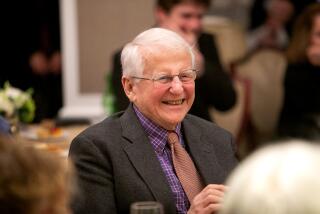Book review: ‘Robert Redford: The Biography’ by Michael Feeney Callan
- Share via
In Michael Feeney Callan’s fawning new biography, we get plenty of the actor, director and environmentalist we already know but only a tantalizing, too-brief glimpse of a young man we almost never hear about: Charles Robert Redford Jr., Angeleno.
From his difficult birth as a blue baby in a Santa Monica hospital until he left for the University of Colorado on a baseball scholarship, Redford lived most of his life in Southern California. His father took the family on weekly outings to the Santa Monica Public Library, where young “Charlie” devoured Greek mythology. His mother squired her son to the Aero for an arguably formative 23 viewings of “Bambi,” until John Garfield displaced Thumper in his affections.
FOR THE RECORD:
Robert Redford: A review of “Robert Redford: The Biography” by Michael Feeney Callan in the May 16 Calendar section said that Redford had anchored the varsity pitching rotation with Don Drysdale at Van Nuys High School and earned a baseball scholarship at the University of Colorado. Redford did not anchor the pitching rotation with Drysdale or earn a baseball scholarship. Neither assertion appears in the manuscript of the book. —
Redford went to Van Nuys High, where he and Don Drysdale anchored the varsity pitching rotation. And the next time you visit the Fox Westwood Village theater, picture the eventual star of “Jeremiah Johnson” mounting a successful if unsanctioned teenage ascent of its gleaming, glacial southern face.
If we don’t tend to claim Redford as ours, maybe it’s because he made a point of knocking the local topsoil off his boots the minute he could and spending his first decent paycheck on land in the Rockies instead. As he tells Callan in one of the book’s more revealing quotes, “I lived through that moment when Los Angeles traded its rural soul to a smog-spewing industry machine, and it made me very sad.”
Regardless of whether you buy Redford’s caricature of postwar L.A. as some dewy virgin sullied beyond saving by tailpipes and cigars, it’s by far the freshest part of Callan’s book. After Redford gets to New York and decides he’s more cut out for acting than painting, the roles onstage and in the movies soon begin to whiz by without too much differentiation.
Redford’s made easily half a dozen of the most interesting and important movies of the last 40 years, but he doesn’t say much to his all-but-authorized biographer here that makes a reader all that eager to go back and watch any of them again. The cumulative effect resembles one of those watchable but unenlightening life-achievement clip fests that bog down the Oscars.
Callan’s principal problems as a biographer boil down to (1) indifferent prose, (2) too much access and (3) an earnest Irishman’s shaky sense of a country and culture he didn’t grow up in. He’s not a bad writer, exactly, and even has a couple of well-received novels to his name back home, alongside biographies of Anthony Hopkins, Richard Harris, Sean Connery and Julie Christie. But those actors are, respectively, a Welshman, an Irishman, a Scot and an India-born Englishwoman. To tell a love story as American as the one between Redford and his audience, it might have helped to remember some of its more public events personally and not have to reconstruct them secondhand from clippings in the academy library.
Callan’s facile writing only rises to memorability for the wrong reasons. For instance, he’s apparently deaf to the silliness of describing Redford at one point as “surrounded by bougainvillea (his favorite shrub).”
His favorite shrub? Callan’s plainly setting us up here for a moment 30 pages later, when Redford will try to call his embryonic Utah filmmaking workshop “Bougainvillea” instead of “Sundance.” But even that excuse may not keep His Favorite Shrub from becoming ready editorial shorthand for way too much undigested biographical detail.
A bigger flaw intrudes whenever Callan’s subject opens his mouth — which, after 14 years of conversations with him, is often. In interviews elsewhere, Redford can come across as thoughtful and self-deprecating, but not here. “I was unimpressed with show,” he pronounces of his rugged teenage iconoclasm. About “Ordinary People,” and the Oscar rigmarole attendant on it, he intones sententiously, “I did not desire accolades.”
Redford is a talented, charming man whose children, wife and even his ex-wife all apparently still like him. He didn’t invent the independent film movement singlehandedly, but it’s a makable case that he midwifed it. So why does he have to talk to his biographer like someone giving dictation to an engraver?
All Callan’s access to Redford poses another problem: It doesn’t leave enough room for other intelligent voices to weigh in. The directors Michael Ritchie, George Roy Hill and Sydney Pollack provide the best of the backing vocals, but we hear from them only occasionally.
From the unfailingly savvy film observer William Goldman, who’s written more Redford movies than any other screenwriter, we hear not a word. Redford admits that rewrites of “All the President’s Men” cost him Goldman’s friendship, and Callan contends that “about one-tenth of Goldman’s draft remained in the end,” but considering that Goldman’s own account in the classic “Adventures in the Screen Trade” differs from Redford’s and Callan’s in just about every particular, mightn’t at least a brief chat with the man who won an Oscar for writing the picture have been in order? Or did the publicity powerhouse PMK — one of whose flacks Callan mysteriously acknowledges as the “project’s manager from its earliest days” — exercise veto power over sources who’ve had the misfortune to fall off the star’s Christmas list?
Even worse of all are the kid gloves Callan uses to discuss the whole last third of Redford’s filmography. Not hating “Indecent Proposal” is forgivable, at least in isolation. But failing to mention the monotonous mediocrity of almost every Redford film after “Quiz Show” — “Up Close & Personal,” “The Horse Whisperer,” “The Legend of Bagger Vance,” “The Last Castle,” “The Clearing,” “An Unfinished Life,” “Lions for Lambs,” etc. — isn’t just dishonest, it’s a missed opportunity.
As Callan rightly points out, Redford’s a man whose earliest good movies all describe the emptiness of success: “Downhill Racer,” “The Candidate,” “The Way We Were.” How does such a man cope with actual failure? Don’t stand on one foot waiting for Callan to ask him. Does a taxidermist ask tough questions of an elk?
Details:
Robert Redford
The Biography
Michael Feeney Callan
Alfred A. Knopf: 468 pp., $27.95
Kipen is a former San Francisco Chronicle book critic.
More to Read
Sign up for our Book Club newsletter
Get the latest news, events and more from the Los Angeles Times Book Club, and help us get L.A. reading and talking.
You may occasionally receive promotional content from the Los Angeles Times.










